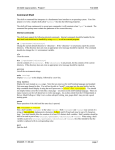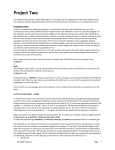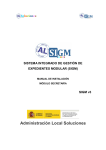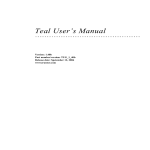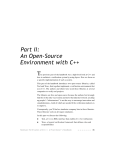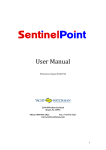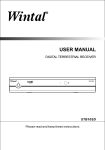Download Command Shell
Transcript
CS 3204 Project 1
Fall 2005
Command Shell
The shell or command-line interpreter is the fundamental user interface to an operating system. Your first project is to write a
simple shell that has the following properties.
The shell will loop continuously to accept user commands; it will terminate when "quit" is entered. The command line
prompt must contain the pathname of the current directory.
Internal commands
The shell must support the following internal commands:
cd [[<pathname>]<directory>]
Change the current default directory to <directory>. If the <directory> is not present, report the current
directory. If the directory does not exist an appropriate error message should be reported. The command should also
change the PWD environment variable.
clr
Clear the screen.
dir [[<pathname>]<directory>]
Llist the contents of <directory>. If the <directory> is not present, list the contents of the current directory.
If the directory does not exist an appropriate error message should be reported.
environ
List all the environment strings.
echo <comment>
Write the string <comment> on the display, followed by a new line.
help
Display the user manual using the more filter.
pause
Pause operation of the shell until the enter key is pressed.
quit
Quit the shell.
Internals commands are handled by the shell itself. This may involve making calls to API functions provided by the
underlying operating system. You should not simply invoke features of an underlying shell from which your shell may have
been started.
Program invocations
All other command line input is interpreted as program invocation, which should be done by the shell forking and
executing the program as its own child processes. The programs should be executed with an environment that contains the
entry: parent=<pathname>/myshell as described above. Upon finding the executable, the shell will echo the full path
from the system root to the directory where the executable was found. If the executable is not found, the shell will issue an
informative error message.
Path specifications
When appropriate, the user may include path specifications in commands, as indicated by <pathname> in the internal
command specifications above, and elsewhere. The shell will accept path specifications that start with "/", "./" and
"../".
9/22/2005 8:46 AM
1
CS 3204 Project 1
Fall 2005
Path specifications are not required. In a program invocation, when no explicit path is given to an executable, the shell will
search for the executable according to the values in the environment variable PATH. This value must be retrieved using the
UNIX system call getenv().
The shell environment should contain shell=<pathname>/myshell where <pathname>/myshell is the full path
for the shell executable (not a hardwired path back to your directory, but the one from which it was executed)
Other considerations
The shell must take into account the attributes of relevant files. For example, if the command "/usr/home/me/foo" is
entered and the specified file exists in the specified location, but it is not executable, the shell will issue an informative error
message.
The shell must support I/O redirection on either or both stdin and stdout. That is, the command line
programname arg1 arg2 < inputfile > outputfile
will execute the program programname with arguments arg1 and arg2, the stdin file stream replaced by inputfile
and the stdout file stream replaced by outputfile.
stdout redirection should also be possible for the internal commands dir, environ, echo and help.
With output redirection, if the redirection token is '>' then the output file is created if it does not exist, and truncated if it
does and its write permissions are set. If the redirection token is '>>' then the output file is created if it does not exist,
and appended to if it does. When an output file is created using redirection, its access permission must at least include read
permission for the owner. If redirection targets an existing file whose write permissions are not set, the shell will issue an
informative error message.
The shell must support background execution of programs. An ampersand '&' at the end of a command line indicates that
the shell should return to the command prompt immediately after launching that program.
Changes to shell environment variables should be registered using setenv() or putenv() so those values will be visible
when external program invocations are made. When your shell exits, the environment should be restored to the same state as
before the shell was started.
User documentation
You must write a simple user manual describing how to use the shell. The manual should contain enough detail for a UNIX
beginner to use it. For example, you should explain the concepts of I/O redirection, the program environment, and
background program execution. The manual must be named readme (no extension) and must display properly if opened in
vi or emacs.
For an example of the sort of depth and type of description required, you should take a look at the online manuals for one or
more of the common UNIX shells (csh, tcsh, bash, etc.). Of course, those shells are much more complex than yours will
be, so your manual will not be so large.
The user manual should not contain build instructions, an included file list, or source code. This is a User Manual, not a
developer's guide.
9/22/2005 8:46 AM
2
CS 3204 Project 1
Fall 2005
Design and implementation requirements
There are some explicit requirements, in addition to those on the Programming Standards page of the course website:
Your shell must be implemented in ISO-compliant C/C++ code. You may make use of any language-standard types
and/or containers you find useful.
You must decompose your implementation into separate source and header files, in some sensible manner that
reflects the logical purpose of the various components of your design.
You must document your implementation according to the Programming Standards page on the course website.
You must properly allocate and deallocate memory, as needed.
If your shell does not implement a specified feature, it should write an appropriate disclaimer when the user attempts
to use that feature, something distinguishable from a normal error message resulting from a logically invalid
command. Any such omissions should also be documented in the User Manual.
In general, you are expected to apply the design and implementation guidelines and skills covered in your previous computer
science courses. There is no requirement that you base your design on an object-oriented analysis of the problem, nor are
you discouraged from doing so. You may implement your solution in pure C, or in C++.
Suggestions and assumptions
There are some explicit assumptions you may make:
No command line will be longer than 100 characters, and no command will be given more than 10 arguments, not
counting redirection and '&'.
Each command argument, redirection symbol and '&' will be preceded by at least one blank space.
You may find it helpful to consult the UNIX man pages on fork(), exec(), getenv(), access(), waitpid(),
opendir(), and related UNIX features cited in those man pages.
You may also find it helpful to look up the C library function freopen(). Note that there are many good online C/C++
language references and that if you have installed the Microsoft Visual C++ documentation that does include a
comprehensive language reference.
Here is an example of a C++ style internal command handler:
void cdHandler( istringstream& User ) {
string newDirectory;
User >> newDirectory;
}
// get target directory
if ( newDirectory.length() == 0 ) { // no target directory, echo current
cout << Environ.PWD << endl;
}
else if ( newDirectory == "./" || newDirectory == "." ) {
// no change
return;
}
else {
string newPWD = findNewPWD( newDirectory ); // clean up vble
Environ.PWD = newPWD;
// set internal vble
setenv("PWD", newPWD.c_str(), true);
// set system vble
}
9/22/2005 8:46 AM
3
CS 3204 Project 1
Fall 2005
Evaluation
Shortly before the due date for the project, the TA will post signup sheets inside the McB 124 lab. You will schedule a demo
with the TA. At the demo, you will perform a build, and run your program on the demo test data, which I will provide to the
TA. The TA will evaluate the correctness of your results. In addition, the TA will evaluate your project for good internal
documentation and software engineering practice.
Remember that your implementation will be tested in the McB 124 lab environment. If you use a different development
platform, it is entirely your responsibility to make sure your implementation works correctly in the lab.
Your implementation will be evaluated for documentation and design, as well as for correctness of results. Note that the
evaluation of your project may depend substantially on the quality of your code and documentation.
What to turn in and how
This assignment will be collected on the Curator system. The testing will be done under Fedora Core 4 using gcc 4.0.1. The
Curator will not begin accepting submissions of this assignment before September 10.
Submit a single gzip'd tar file containing the C/C++ source and header files for your implementation to the Curator System.
Submit only the source and header files. Submit nothing else. Be sure that your header files only contain include
directives for Standard C/C++ and UNIX header files; any other include directives will certainly result in compilation
errors.
It must be possible to unpack the file you submit using the following command:
tar –zxf <name of your file>
The unpacked files will then be compiled, typically using the following command syntax:
[g++ | gcc] –o <name we give the executable> [*.cpp | *.c]
Instructions, and the appropriate link, for submitting to the Curator are given in the Student Guide at the Curator website:
http://www.cs.vt.edu/curator/.
You will be allowed to submit your solution up to three times in order to fix errors you discover before your project is tested.
Your latest submission will be tested.
Pledge
Each of your program submissions must be pledged to conform to the Honor Code requirements for this course. Specifically,
you must include the pledge statement provided on the Programming Standards page in one of your submitted files.
9/22/2005 8:46 AM
4




